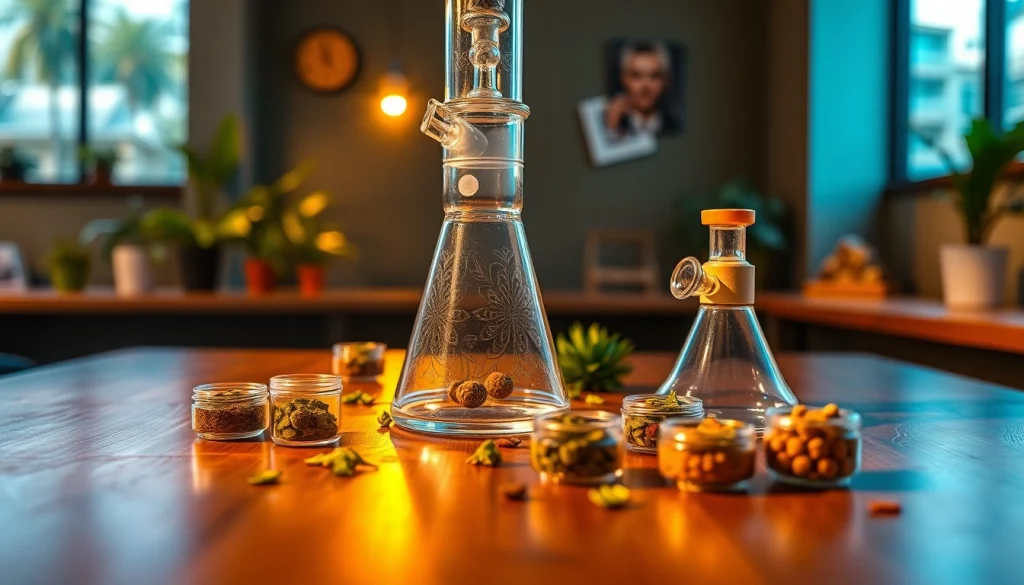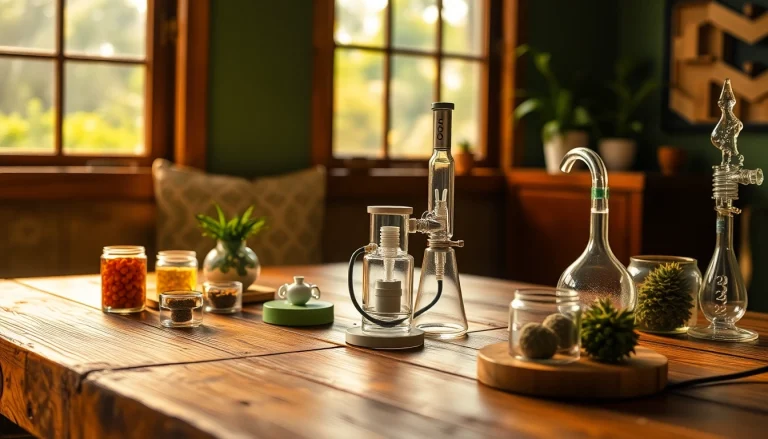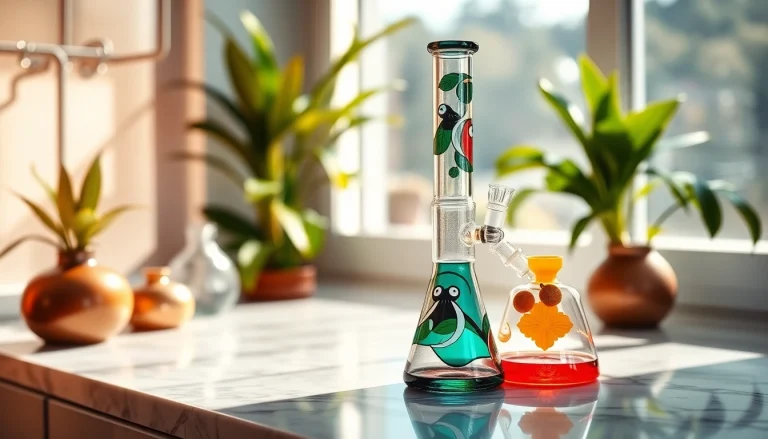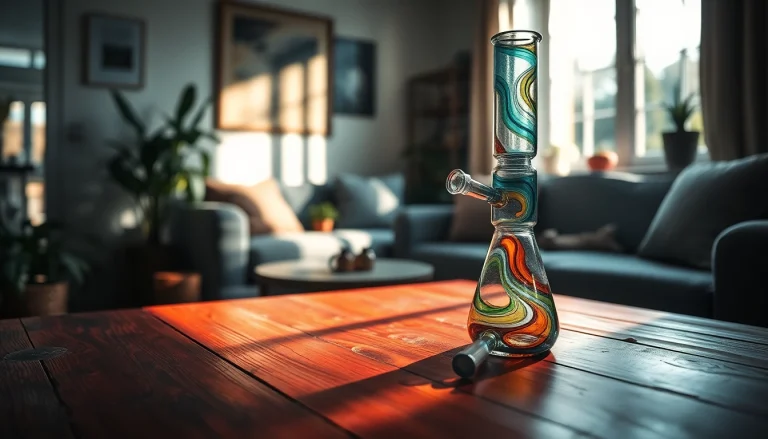
Understanding the Bong: A Beginner’s Guide
What is a Bong?
A bong is a type of filtration device commonly utilized for smoking cannabis, tobacco, or other herbal substances. Designed to cool and filter the smoke before inhalation, bongs vary significantly in size, shape, and material. Typically, a bong consists of a bowl (where the substance is packed), a stem (the tube leading from the bowl to the water), and a chamber (the area where water is held). Smoke is drawn through the water, which filters out impurities, providing a smoother smoking experience. Given their efficiency in smoke filtration, bongs have been embraced by enthusiasts for generations.
The History of Bongs and Their Cultural Significance
The origins of bongs can be traced back over 2,400 years to ancient cultures in Asia, particularly in regions like China and India. The term “bong” is derived from the Thai word “bong,” referring to a water pipe. These historical devices were primarily used for consuming cannabis, and their design has evolved significantly over time. In cultures such as those in Africa, bongs, or similar water pipes, have played ceremonial and social roles, demonstrating the device’s cultural importance beyond mere consumption.
As bongs spread across the globe, they have been integrated into various cultures, with unique adaptations reflecting local materials and customs. For instance, in Western countries, the popularity of bongs soared in the 1960s and 1970s during the counterculture movement, symbolizing rebellion and a connection to nature. Today, bongs are not just seen as tools for consumption; they are often regarded as artistic expressions, adorned with intricate designs and crafted from diverse materials.
Types of Bongs: Glass, Acrylic, and Beyond
When it comes to bongs, variety is the spice of life. Here are the most common types:
- Glass Bongs: Arguably the most popular choice due to their aesthetic appeal and the purity of taste they provide. Glass bongs can come in a range of designs, often featuring intricate artwork and effective percolation systems.
- Acrylic Bongs: More affordable and durable than glass options, acrylic bongs offer a lightweight alternative. These are ideal for beginners or for those needing a travel-friendly option.
- Ceramic Bongs: Known for their artistic designs, ceramic bongs can be a centerpiece in any collection. They offer good filtration but may not be as durable as glass or acrylic.
- Metal Bongs: Often made from aluminum or other metals, these bongs are durable and portable but might affect the taste of the smoke.
- Hybrid Bongs: Some bongs incorporate multiple materials, offering unique benefits like improved durability and aesthetics.
How to Choose the Right Bong for Your Needs
Key Features to Consider When Buying a Bong
Choosing the right bong depends on several factors, including personal preferences and intended use. Here are essential features to keep in mind:
- Size: Bongs come in various sizes, and larger bongs can hold more water, but they might be less portable. Smaller bongs may be easier to handle and transport.
- Material: As discussed in the previous section, the material affects durability, flavor, and ease of cleaning. Consider what’s most important for your usage.
- Percolation: Percolators enhance filtration, which can dramatically improve the smoothness of your smoke. Bongs with multiple percolators offer more complex filtration systems but may require more maintenance.
- Bowl Size: Larger bowls can hold more substance, but smaller bowls facilitate more controlled smoking sessions, especially for beginners.
- Design: Personal taste plays a big role in choosing a bong. Whether you prefer minimalist designs or colorful patterns, there’s something for everyone.
Understanding Bong Size and Its Impact on Smoking
The size of a bong significantly affects the smoking experience. Smaller bongs, usually around a foot in height, provide a more compact, portable option, making them ideal for traveling. They typically require less water, making maintenance easier, and allow users to take quicker hits. However, their smaller chambers mean the smoke may not be as cooled or filtered as effectively compared to larger bongs.
On the other hand, larger bongs can provide a smoother experience thanks to increased filtration. They allow for bigger hits and might cool the smoke more effectively. However, they can be cumbersome and less portable. For social settings, larger bongs can serve as a focal point and provide a shared experience among friends.
Comparing Bong Materials: Which is Best for You?
The material of your bong can have just as much impact on your smoking experience as the size and design. Here’s a deeper look into the pros and cons of each material:
Glass Bongs
Pros:
- Pure flavor; does not alter the taste of the smoke.
- Visually appealing with artistic designs.
- Easy to clean.
Cons:
- Can be fragile and easily breakable.
- Typically more expensive than other materials.
Acrylic Bongs
Pros:
- More durable and resistant to breaks.
- Less expensive than glass bongs.
Cons:
- Can affect the taste of the smoke over time.
- Less aesthetic appeal compared to glass bongs.
Ceramic Bongs
Pros:
- Durable; often more resistant to breaking than glass.
- Beautiful designs that serve as art pieces.
Cons:
- Can be heavy and challenging to clean.
- Expensive depending on the design.
Metal Bongs
Pros:
- Extremely durable and portable.
- Good choice for travel.
Cons:
- May affect flavor.
- Can become hot with extended use, making it uncomfortable.
Hybrid Bongs
Pros:
- Can combine the benefits of different materials.
- Often designed innovatively to enhance the experience.
Cons:
- Could be challenging to clean if the materials are not compatible.
- Price can vary significantly depending on the design.
How to Properly Use a Bong: Step-by-Step Guide
Preparing Your Bong for Use
Before using your bong, it’s critical to prepare it properly:
- Fill with Water: Pour water into the bong through the top opening until it submerges the end of the downstem by about an inch.
- Check for Leaks: Ensure that the water doesn’t leak from any part of the bong; a well-sealed joint between the downstem and the bong is essential.
- Pack the Bowl: Using ground cannabis, fill the bowl gently, making sure not to pack it too tightly to allow airflow.
How to Pack and Light Your Bong Effectively
Once everything is set up, it’s time to light your bowl:
- Place your mouth over the mouthpiece and create a tight seal.
- As you ignite the bowl, begin to inhale gently, allowing the smoke to travel through the water and into your lungs.
- Remember to clear the bowl by removing the lighter flame once you feel the smoke filling your lungs; this will help prevent harsh hits.
Common Mistakes to Avoid When Using a Bong
Even with the best setup, beginners often make some common errors:
- Using too much water: Overfilling can cause splashback, which can be unpleasant.
- Not cleaning your bong regularly: Residue build-up can affect the taste and potency.
- Packing the bowl too tightly: This prevents proper airflow, resulting in harsher hits.
Maintaining Your Bong: Best Practices for Longevity
Essential Cleaning Techniques for Different Bong Types
Regular maintenance is vital for enjoying a better smoking experience. Based on the material, follow these cleaning techniques:
Glass Bongs
For glass bongs, use a mixture of isopropyl alcohol and coarse salt. Shake the mixture and rinse thoroughly. A pipe cleaner can help reach tight areas.
Acrylic Bongs
Acrylic bongs can be cleaned with warm soapy water and a sponge. Avoid abrasive cleaners to prevent scratching.
Ceramic Bongs
Clean ceramic bongs using a mild cleaning solution and a soft cloth. Rinse thoroughly to prevent lingering residue.
Metal Bongs
For metal bongs, use a warm, damp cloth or sponge. Avoid using abrasive materials that can scratch the surface.
How Often Should You Clean Your Bong?
The frequency of cleaning your bong largely depends on how often you use it. As a general rule, it is advisable to clean your bong after every few uses, or at least once a week, to ensure optimal flavor and cleanliness. Regular maintenance not only enhances the smoking experience but also prolongs the life of your bong.
Preventing Congestion and Bacteria Growth in Your Bong
To prevent congestion and bacteria growth, ensure the following practices:
- Use clean water each time you smoke.
- Ensure your bong is dried properly after cleaning to prevent mold growth.
- Consider using antimicrobial cleaning solutions to enhance cleanliness.
Exploring Advanced Bong Features: What’s New?
Innovative Bong Designs and Technology
As the smoking community grows, so does the design of bongs. Innovations such as modular bongs, which allow users to swap out chambers and percolators, give customizability to the user. Moreover, new materials like silicone have gained popularity due to their flexibility and durability, providing a travel-friendly option without sacrificing functionality.
Understanding Percolators and Their Benefits
Percolators are enhancements found in many modern bongs that serve to further filter and cool the smoke. They work by forcing the smoke to pass through water multiple times, increasing the contact with water and resulting in smoother hits. Types of percolators include tree, honeycomb, and showerhead, each offering distinct advantages in terms of filtration efficiency and aesthetic appeal.
Accessories to Enhance Your Bong Experience
To elevate your smoking experience further, consider incorporating accessories such as:
- Grinders: Ensure your cannabis is evenly ground for optimal packing and burning.
- Coolers: Some bongs come with attachments that cool smoke even further.
- Diffusers: These accessories disperse the smoke into smaller bubbles, enhancing filtration and cooling.



